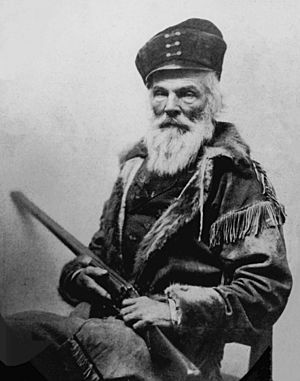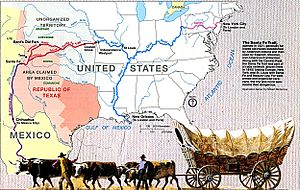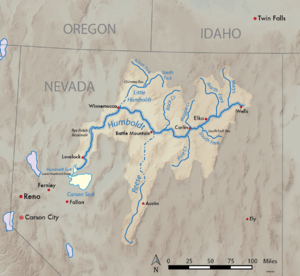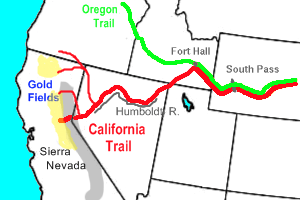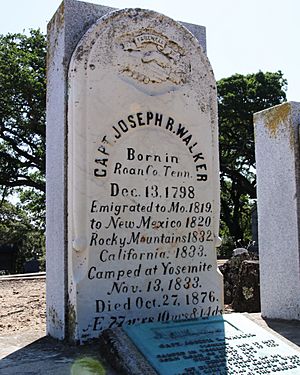Joseph R. Walker facts for kids
Joseph R. Walker (born December 13, 1798 – died October 27, 1876) was a brave mountain man and an expert scout. He helped create an important part of the California Trail. This trail was the main path for people moving to California during the California Gold Rush. He mapped the route from Fort Hall, Idaho to the Truckee River. The Walker River and Walker Lake in Nevada are named after him. John C. Frémont, another famous explorer, gave them these names.
Contents
Early Life of a Pioneer
Joseph Walker was born in Roane County, Tennessee. He was the fourth of seven children. In 1819, his family moved to Missouri, settling near Fort Osage. In 1820, he traveled to Santa Fe. Spanish officials held him for a short time there. He might have been one of the "Taos trappers," catching beavers in what was then Spanish/Mexican territory. He also worked on the Santa Fe Trail with Old Bill Williams. Walker later returned to Missouri. In 1827, he became the sheriff of Jackson County.
Exploring California and the Great Basin
In 1830, Walker was moving horses to Fort Gibson in Oklahoma. There, he met Benjamin Bonneville. Walker wanted to explore the American frontier. Bonneville offered him a chance to join his expeditions. In 1832, Walker left Fort Osage with Bonneville and 110 other men. They traveled to the Green River in Wyoming.
In 1833, Bonneville put Walker in charge of a group of men. This group included Old Bill Williams and Zenas Leonard. Their mission was to explore the Great Salt Lake. They also needed to find a land route to California. They started on July 27. They found a path along the Humboldt River in what is now Nevada. They followed it to the Humboldt Sink. Then, they made their way to Genoa, Nevada, at the base of the Sierra Nevada.
They started climbing the Sierra Nevada by going up the west fork of the Carson River. They tried to find a way over the mountains. Finally, they reached the top of the Stanislaus River. They followed it down to the Central Valley of California.
On February 14, 1834, Walker and his 52 men started their trip back from California. They crossed the Sierra Nevada through a southern pass. The group reached Owens Valley on May 1, 1834. They traveled north in the valley. They became impatient and decided to turn east. They left the valley on May 10. But they soon worried about not having enough water. They went back west to the Sierra Nevada mountains. They traveled north to the Humboldt Sink. Then, they returned to the Rocky Mountains the same way they had come.
Later, Joseph Walker married a Shoshone woman.
In 1840, Walker and his group made the first known north-to-south crossing of the eastern Great Basin by Americans. They started from Browns Park along the Green River. Walker and his men crossed the Wasatch Range to the Sevier Lake. They traveled south to the upper Virgin River. They followed it to where it met the Colorado River. From the Colorado, they crossed the Mojave Desert to Los Angeles. There, Walker sold beaver furs. He also bought horses with the help of Abel Stearns. Walker left California with many horses and mules.
Leading Emigrants West
After traveling to California in 1841, Joseph Chiles returned to Missouri. He organized the first wagon train of people heading to California in 1843. At Fort Laramie, Chiles hired Walker to guide the wagon train. Walker was paid $300 for this job.
In August, at Black's Fork of the Green River, the group rested. They tried to get dried meat for the journey. They were not very successful. They could only get four cattle at Fort Hall. So, Walker and Chiles decided to split the group. This way, they could make the best use of their food.
After leaving Fort Hall on September 16, Chiles took 13 men on horseback. They went to Fort Boise for more food. If food was not there, he was to cross the Sierra Nevada near the Truckee River. Then, he would go to Sutter's Fort for supplies. He would bring the food back across the Sierra to Humboldt Sink. Walker and the wagon train would be waiting there. Once reunited, they would go south through the Owens Valley. They would follow the eastern side of the Sierra Nevada to a southern pass. Walker thought wagons could cross there.
Chiles's group could not get food at Fort Boise. They went far north around the Sierra Nevada instead of crossing at the Truckee River. Chiles reached Sutter's Fort on November 11. Walker's group left the Humboldt Sink around November 1. They traded horseshoe nails for fish with the Paiute people at what became Walker Lake.
The animals were too weak to pull the wagons past Owens Lake. This might have been because of a drought. The wagons were left behind there. The group continued on foot. They crossed the Sierra Nevada mountains on December 3, 1843. After that, they crossed the San Joaquin Valley and the Coast Range. They spent the winter in Peachtree Valley. This journey helped map 500 miles of what would become the California Trail. This part of the trail went from Fort Hall (Idaho) to the Truckee River (Nevada and California).
Scouting with Frémont
After the expedition, Walker got permission to trade again. In April 1844, he left southern California with horses and mules. He traveled along the Old Spanish Trail. He caught up with John C. Frémont's second expedition near Las Vegas. Walker and Frémont had met before in 1842. Walker had turned down an offer to guide that expedition. Walker's group traveled with Frémont to Bent's Fort in Colorado. Then, they went their separate ways.
In 1845, Walker, his wife, and his followers joined Frémont's third government expedition. They met at White River in eastern Utah. This trip was going to California and Oregon. Frémont had hired Bill Williams and Kit Carson. But Walker was chosen as the main guide.
Captain Philip St. George Cooke described Walker: "This afternoon Mr. Walker visited our camp. He has gathered a small group. They look wild, both white and Native American. This man has left city life. He married a Native American woman and prefers to live wandering in these deserts. He does some hunting, trapping, and trading. This is enough for a leader of native groups. He is a very smart man. He seems brave and good at finding solutions."
Walker led the main part of the expedition down the Humboldt River to Walker Lake. There, they met Frémont and a smaller group. Frémont's group had taken a more southern path. The party split again. Walker took the main group to where Lake Isabella is now, in December. Frémont and a small group crossed the Sierra Nevada near the Truckee River. They eventually reached Sutter's Fort in California. The two groups missed their planned meeting place along the Kings River. But they met again in February 1846.
Later Years
In 1862–63, Walker led a group of 34 men looking for gold. They went into the mountains of central Arizona, near what is now Prescott. The group found gold along the Hassayampa Creek and Lynx Creek. This discovery led to more white settlers moving into the area. The village of Walker, Arizona, is named after him.
Walker returned to his family's ranch in Contra Costa County, California, in 1867. He died there on October 27, 1876. He is buried in the Alhambra Cemetery in Martinez, California.
See also
 In Spanish: Joseph Walker para niños
In Spanish: Joseph Walker para niños


